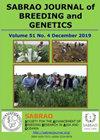ESTIMATION OF COMBINING ABILITY EFFECTS FOR YIELD AND FATTY ACID-RELATED TRAITS IN BRASSICA RAPA USING LINE BY TESTER ANALYSIS
IF 1.7
Q3 PLANT SCIENCES
引用次数: 0
Abstract
Brassica rapa is an important oilseed crop in Pakistan. It is a rich source of oil and contains 40%–46% oil. In addition, its meal has 38%–40% protein. Given their high levels of erucic acid and glucosinolate, mustard and rapeseed oil is unhealthy as regular cooking oil. A dire need to exploit the genetic variability of rapeseed germplasm is necessary to improve the performance of cultivars. The line × tester analysis helped estimate various types of gene actions that are important to quantitative traits. The key to successful research is selecting suitable lines and testers and designing good mating patterns. Choosing and developing genotypes with high yield and fatty acid profiles are the major concern of rapeseed breeders. The current research on hybridization and evaluation of Brassica rapa accessions sought better harvest and its related traits from the selected germplasm. The combining ability effects determination used line × tester analysis in rapeseed. The accessions’ variability analysis exhibited extremely significant differences in yield and related traits. Recorded data for different morphological and yield-related qualities provided days till 50% flowering, the number of major branches per plant, and the number of secondary branches per plant had positive and significant general combining ability estimates, and all yield-related variables had extremely notable specific combining ability estimates. All the yield-related characteristics displayed a favorable and substantial connection in the examined germplasm. Among the lines, 28244, 40980, and 40981 occurred to be the best general combiners showing the additive gene action. The cross combinations, 40977 × 26283, 40979 × 26283, and 40981 × 26283, indicated significant specific combining ability effects, which showed the non-additive genetic effects of total variance due to the dominance and/or epistasis. The results suggested that the research material used in the remarkable study can benefit by improving yield and fatty acids-related components and can further enhance upcoming breeding programs based on strong particular combining ability impacts.用试验分析法评价油菜产量和脂肪酸相关性状的配合力效应
油菜是巴基斯坦重要的油料作物。它是一个丰富的油源,含油量为40%-46%。此外,其膳食中含有38%-40%的蛋白质。考虑到芥酸和硫代葡萄糖苷的高含量,芥末油和菜籽油和普通食用油一样不健康。利用油菜种质资源的遗传变异是提高油菜品种生产性能的迫切需要。行x测试仪分析有助于估计对数量性状重要的各种类型的基因作用。研究成功的关键是选择合适的品种和试验设备,设计良好的配种模式。选择和开发具有高产和脂肪酸谱的基因型是油菜籽育种者关注的重点。目前对油菜种质资源的杂交和评价研究是为了从所选种质中寻求更好的收获及其相关性状。油菜配合力效应测定采用系×试验分析。变异分析表明,各品种在产量及相关性状上存在极显著差异。不同形态和产量相关性状的记录数据提供了开花至50%的天数、单株主枝数和单株次枝数的一般配合力估计值为正且显著,所有产量相关变量的特定配合力估计值均极显著。所有与产量有关的性状在检验的种质中都表现出良好的、实质性的联系。其中,28244、40980和40981是表现加性基因作用的最佳一般组合。40977 × 26283、40979 × 26283和40981 × 26283的特异配合力效应显著,表明总方差存在显性或上位性的非加性遗传效应。结果表明,该研究中使用的研究材料可以通过提高产量和脂肪酸相关成分来获益,并可以进一步加强基于强特定配合力影响的育种计划。
本文章由计算机程序翻译,如有差异,请以英文原文为准。
求助全文
约1分钟内获得全文
求助全文
来源期刊

Sabrao Journal of Breeding and Genetics
农林科学-奶制品与动物科学
CiteScore
1.90
自引率
50.00%
发文量
63
期刊介绍:
The SABRAO Journal of Breeding and Genetics is an international journal of plant breeding and genetics research and was first published in 1969. It is the official publication of the Society for the Advancement of Breeding Research in Asia and Oceania (SABRAO).
Its objectives are to: promote the international exchange of research information on plant breeding and genetics, by describing new research findings, or ideas of a basic or practical nature; and be a medium for the exchange of ideas and news regarding members of the Society.
The Journal gives priority to articles that are of direct relevance to plant breeders and with emphasis on the Asian region. Invited for publication are research articles, short communications, methods, reviews, commentaries, and opinion articles. Scientific contributions are refereed and edited to international standards.
The journal publishes articles for SABRAO members mainly. The Journal preferred strongly that at least one author should be a current member of the Society. Non-members may also publish in the journal.
 求助内容:
求助内容: 应助结果提醒方式:
应助结果提醒方式:


